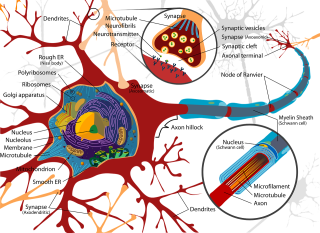Neuroscience
6 Ways Your Brain Makes You Who You Are
86 billion neurons, firing your self into existence.
Posted January 19, 2023 Reviewed by Michelle Quirk
Key points
- As our mind-states fluctuate, so do our neural landscapes.
- Emotion and cognition are multiple sides of the same system.
- We are who we are because of the way our brains allow us to interact with the world.
In a century and a half, neuroscience has revealed no shortage of wonders about the brain. For example, the average adult brain contains around 86 billion diversely specialized, minuscule (0.1 millimeters in diameter) neurons that make it possible for humans to experience a richly nuanced existence. Our very ability to think, to love, to enjoy a sunset emerges from the “spatiotemporal orchestration” of these heavy-lifting neurons.
There are at least 1,000 times more neuronal connections called synapses in our brains (100 trillion) than there are stars in our galaxy. Signals travel through synapses at different speeds. Along the spinal cord, they can reach up to 268 miles per hour, while in the sensory receptors of the skin, they plod at a mere 1 mph. If smoothed out, the cerebral cortex, which is the brain’s outer layer (cortex means “bark” in Latin), stretches to a size of a large pizza. To help us pack our substantial brains into our small skulls, the cortex begins forming its famous folds and ridges, as early as during week 10 of fetal gestation.

Alongside the discoveries, there have been misconceptions. One of them, according to neuroscientist Luiz Pessoa, is that the brain is best understood through a divide-and-conquer lens—that is, by separating the brain into regions and studying their unique contributions to various mental processes (the most recent cartography of the brain’s anatomy delineates 360 areas with distinct functions and architecture).
Instead, Pessoa suggests that infinitely intricate phenomena, including how the brain gives rise to mental activity, will benefit from exploring how things intertwine and connect rather than separate; how they fit together and interact, rather than isolate. In his new book, The Entangled Brain, Pessoa calls for a more systems-oriented, context-dependent investigation of the brain, as such, inviting us to open to the full complexity of what it means to be human.
Here are six insights about the brain from Dr. Pessoa:
1. Exuberance of Connectivity
According to Pessoa, among the brain’s most astounding properties is its “massive combinatorial connectivity.” Like in any well-connected community where rumors spread nimbly among its members, the brain’s highly structured anatomical entanglement allows signals to travel between neurons in countless combinations, even across parts of the brain that are not directly linked. This “global accessibility” makes our brains highly efficient.
A richly connected brain begets a particular way of thinking about it: more in terms of circuits and networks, less in terms of isolated regions; more in terms of a collection of interacting systems, less in terms of boxes and arrows. “The network itself is the unit,” writes Pessoa, “not the brain area.” For instance, instead of referring to attention as being located in the parietal cortex, Pessoa considers attention as something that emerges from the activity of multiple networks of brain regions (frontal cortex, parietal cortex, temporal cortex).

Even at the level of networks, the dense arbors of neurons are not completely segregated, explains Pessoa. They share parts. They communicate, often bi-directionally, creating a reverberating system of mutual influences. Each neuron has an effect on multiple cells. The chain of electrochemical communication between neurons starts with the propagation of an electrical signal that travels down an axon—the nerve fiber of a neuron. Upon reaching the synapse at the end of an axon, chemicals (neurotransmitters) are released. So far, scientists have identified around 100 different neurotransmitters, including dopamine and serotonin. These neurotransmitters pass through the synaptic gaps and diffuse into extracellular space, thus affecting nearby neurons. The process of neurotransmission can be impacted by consuming alcohol, drugs, and certain medications.
2. A Dynamic Brain for Our Dynamic Needs
“The brain is not frozen in place but is a dynamic, constantly moving object,” writes Pessoa. The very structure of our brains evolves as we age. Moreover, across moments and hours, our networks shift and adjust in accordance with changes in our cognitive, emotional, and motivational demands. The fluctuations of our mind-states echo throughout our neural landscapes. The functional connections between regions evolve, as coalitions of neuronal networks “form and dissolve to meet the brain’s computational needs, not unlike a group of dancers merging and separating as an act progresses” (Pessoa, 2022).
3. Embracing Complexity
Humans like to make sense of the world by simplifying complex phenomena. Explanations such as “This part of the brain activates when we feel love, and this one when we feel fear,” resonates with us. But biology doesn’t always boil down to simple laws and equations. Pessoa brings the example of a lioness, who leaves her cubs to go hunting and manages to return days later to the same place where she left them. How does her brain give rise to such complex behavior? “The narrative that we prefer is relatively simple: the hippocampus of the animal’s brain acts like a GPS, allowing her to navigate back to her cubs,” he says. But that’s only one part of the story.
When it comes to the brain, it’s all about systems, Pessoa explains:
"Even when we lesion one part of the brain, we can’t isolate its specific contribution, because it is part of an interconnected, highly interdependent system. Yes, there are specific brain regions that are critical for various functions. Yet pointing to an area and saying, 'This is where learning happens' would be like pointing to one particular corner of NYC and saying, 'This is where the essence of New York lives.' After all, the New Yorkness of NYC emerges not from its famous landmarks, but from something much bigger—the interaction of the contents and lifestyles of all the individuals who live there."
4. Nuanced Mental Lives
Knowing about the brain’s highly interconnected nature can serve its users in multiple ways. To begin with, it can help us form more realistic expectations of what constitutes mental health, says Pessoa. Our mental lives cannot be translated into neatly engineered parts that could be easily isolated and manipulated: "A condition like depression or anxiety, for example, will impact not only an individual's emotional life but also multiple functions of their cognition and behavior."
As part of our evolution, the immune system and the nervous system are deeply context-dependent and interdependent. "Why certain things trigger anxiety could do with our experiences, memories, and other factors that are interacting in complex ways—behaviorally and in our brain structures," explains Pessoa.
Similarly, since learning is not separate from memory, which is not separate from emotion, which is not separate from motivation if someone is struggling with schoolwork, it doesn’t automatically mean that they are less intelligent. Maybe they are not paying attention to things that don’t motivate them, Pessoa says: “Humans are not neutral consumers of an external objective reality. Instead, we are actively engaging with the world in a way that loops how we learn, with what motivates us, how we remember things, what we feel.”
The knowledge of the brain’s interconnectedness can invite more nuance into the way we are in the world and how we relate to each other. “Maybe we could even resist the urge to take a given snapshot of an interaction as a testimony for how the person is,” says Pessoa.
5. Blurring the Boundaries Between Emotion and Cognition
Could the quest to find the seat of emotion in the brain be misguided? Yes, according to Pessoa, for the most part thanks to our relentless aspirations to separate multiple parts of the same system. “Emotion—like every other mental domain—is a large-scale network property of the nervous system,” writes Pessoa.
“There’s no section in the brain that we can point to and say, 'That’s the house where emotion lives.' Regions which are important for emotion are also important for attention, learning, and other processes we associate with cognition,” says Pessoa. The reason the amygdala and the hypothalamus are considered key regions for emotion is that they are “important hubs of distributed functionally integrated systems.”
We’ve all experienced the coupling of emotion and cognition in our day-to-day lives. Think of a time when you successfully regulated your emotions by reframing how you thought about your situation. A change in thoughts is often accompanied by a change in feelings. How we interpret things is linked to what motivates us, which is linked to what we pay attention to. For better or worse, emotion and cognition seem to co-inhabit under the same roof, with no intention of getting their own places.
6. Being Human
We are who we are because of the way our brains allow us to interact with the world, explains Pessoa. “If our brain architecture was different, or if we changed our environments, our behavioral and mental repertoires would be affected.” How we learn and grow, how we think and feel, how we remember, how we interact with others—all of these complex properties and behaviors inherently depend on the way our brains are constructed. Thus, with every insight we uncover from the brain’s bottomless catalog of mysteries, we come a step closer to understanding what it means to be human.
The lens of “exuberant connectivity” suggests an infinitely more complicated picture of our biology. But authoring complex states and behaviors are among our coveted inheritances as humans. How fitting, then, that the richness of our behavioral and mental repertoires out in the world parallels the anatomical complexity of our brains.
Many thanks to Luiz Pessoa for his generous time and insights. Dr. Pessoa is a professor of psychology at the University of Maryland and the director of the Maryland Neuroimaging Center.
Facebook/LinkedIn image: Jakub Stanek/Shutterstock
References
Pessoa, L. (2022). The Entangled Brain: How Perception, Cognition, and Emotion Are Woven Together. MIT Press.




